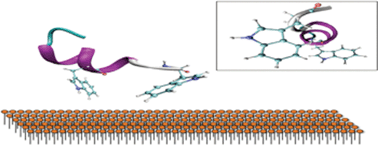 We would like to highlight to you some of the great physical chemistry content published in RSC Publishing’s new high-impact journal, Chemical Science.
We would like to highlight to you some of the great physical chemistry content published in RSC Publishing’s new high-impact journal, Chemical Science.
Chemical Science is dedicated to publishing findings of exceptional significance from across the chemical sciences.
Read all these articles now for free:
Mini reviews
Photodissociation and photoelectron imaging of molecular ions: probing multisurface and multichannel dynamics
Prashant Chandra Singh, Lei Shen, Myung Hwa Kim and Arthur G. Suits
Chem. Sci., 2010, 552-560 ”
Ultrafast studies of single semiconductor and metal nanostructures through transient absorption microscopy
Gregory V. Hartland
Chem. Sci., 2010, 303-309
Perspective article
Future perspectives of nonadiabatic chemical dynamics
Shinkoh Nanbu, Toshimasa Ishida and Hiroki Nakamura
Chem. Sci., 2010, 663-674
Edge articles
Vibrational overtone excitation in electron mediated energy transfer at metal surfaces
Russell Cooper, Igor Rahinov, Zhisheng Li, Daniel Matsiev, Daniel J. Auerbach and Alec M. Wodtke
Chem. Sci., 2010, 55-61
Towards thermochromic and thermoresponsive near-infrared (NIR) luminescent molecular materials through the modulation of inter- and/or intramolecular Pt Pt and π–π interactions
Kenneth Hoi-Yiu Chan, Hoi-Shan Chow, Keith Man-Chung Wong, Margaret Ching-Lam Yeung and Vivian Wing-Wah Yam
Chem. Sci., 2010, 477-482
Energy upconversion sensitized by a platinum(II) terpyridyl acetylide complex
Pingwu Du and Richard Eisenberg
Chem. Sci., 2010, 502-506
Homoleptic copper(I) phenylselenolate polymer as a single-source precursor for Cu2Se nanocrystals. Structure, photoluminescence and application in field-effect transistor
Kam-Hung Low, Cheng-Hui Li, Vellaisamy A. L. Roy, Stephen Sin-Yin Chui, Sharon Lai-Fung Chan and Chi-Ming Che
Chem. Sci., 2010, 515-518
Correlated single quantum dot blinking and interfacial electron transfer dynamics
Shengye Jin, Jung-Cheng Hsiang, Haiming Zhu, Nianhui Song, Robert M. Dickson and Tianquan Lian
Chem. Sci., 2010, 519-526
A versatile, solvent-free methodology for the functionalisation of carbon nanotubes
Robert Menzel, Michael Q. Tran, Angelika Menner, Christopher W. M. Kay, Alexander Bismarck and Milo S. P. Shaffer
Chem. Sci., 2010, 603-608
A novel synergistic enhanced chemiluminescence achieved by a multiplex nanoprobe for biological applications combined with dual-amplification of magnetic nanoparticles
Sai Bi, Hong Zhou and Shusheng Zhang
Chem. Sci., 2010, 681-687
Heterolytic and heterotopic dissociation of hydrogen on ceria-supported gold nanoparticles. Combined inelastic neutron scattering and FT-IR spectroscopic study on the nature and reactivity of surface hydrogen species
Raquel Juárez, Stewart F. Parker, Patricia Concepción, Avelino Corma and Hermenegildo García
Chem. Sci., 2010, 731-738
Preparing water-dispersed palladium nanoparticles via polyelectrolyte nanoreactors
Matthew M. Coulter, Jose Amado Dinglasan, Jane B. Goh, Sreekumari Nair, Darren J. Anderson and Vy M. Dong
Chem. Sci., 2010, 772-775
Submit your physical chemistry research today to Chemical Science!














 HOT Communication –
HOT Communication – 